
Copernicus is a lunar impact crater located in eastern Oceanus Procellarum. It was named after the astronomer Nicolaus Copernicus. It typifies craters that formed during the Copernican period in that it has a prominent ray system. It may have been created by debris from the breakup of the parent body of asteroid 495 Eulalia 800 million years ago.

Ptolemaeus is an ancient lunar impact crater close to the center of the near side, named for Claudius Ptolemy, the Greco-Roman writer, mathematician, astronomer, geographer and astrologer. It measures approximately 154 kilometers in diameter.
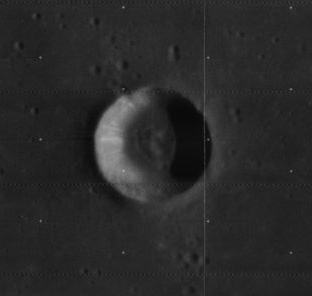
Manners is a lunar impact crater located in the western part of the Mare Tranquillitatis. Its diameter is 15 km. It was named after British astronomer Russell Henry Manners. To the northeast is the larger crater Arago and to the south are Ritter and Sabine. The crater has a rim with a higher albedo than the surrounding mare, making it appear bright. This is a circular, bowl-shaped feature with a raised rim and a relatively flat interior.
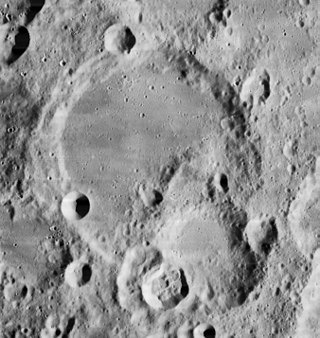
Stöfler is a large lunar impact crater located in the crater-dotted southern highlands. It was named after 15th-16th century German astronomer and mathematician Johannes Stöffler. It sits to the west of the crater Maurolycus. The distorted crater Fernelius is attached to the northern rim, and Miller and Nasireddin lie to the west. Faraday has overlain and damaged the western rim, and this crater in turn has been overlain by several smaller craters.

Burnham is a small crater located to the southeast of the crater Albategnius, in a relatively smooth area of the lunar surface. It was named after American astronomer Sherburne W. Burnham. To the southwest is Vogel.

Bode is a small crater located near the central region of the Moon, to the northwest of the joined craters Pallas and Murchison. It lies on a region of raised surface between the Mare Vaporum to the northeast, Sinus Aestuum to the west, and Sinus Medii to the southeast. The crater was named after German astronomer Johann Elert Bode.
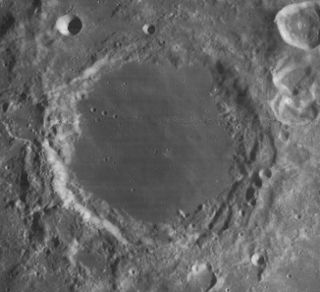
Endymion is a lunar impact crater that lies near the northeast limb of the Moon. It is located to the east of Mare Frigoris and north of Lacus Temporis. To the southwest is the somewhat smaller crater Atlas. Because of its location, Endymion has an oval appearance from foreshortening. Beyond the crater along the lunar limb is the Mare Humboldtianum.
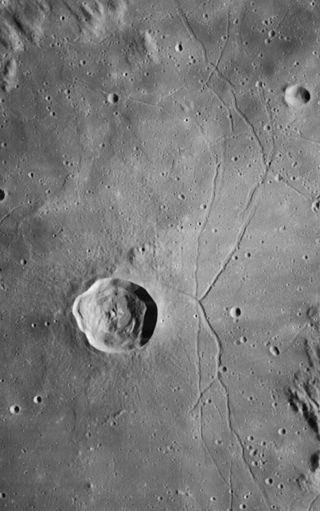
Triesnecker is a prominent lunar impact crater that is located in the Sinus Medii, near the central part of the Moon's near side. Its diameter is 25 km. It was named after Austrian astronomer Franz de Paula Triesnecker. It is located to the north-northwest of the crater Rhaeticus, and to the east-southeast of the flooded Murchison.

Arago is a lunar impact crater located in the western part of the Mare Tranquillitatis. It was named after French astronomer François Arago in 1935. Its diameter is 26 km. To the southwest lies the crater Manners, and beyond are Dionysius and the Ritter–Sabine crater pair. To the southeast is the large Lamont formation that has been submerged by the mare.
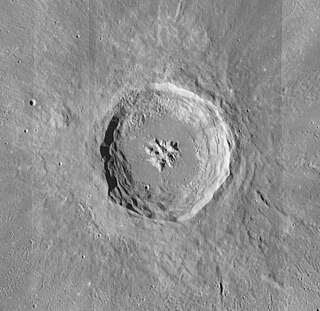
Aristillus is a prominent lunar impact crater that lies in the eastern Mare Imbrium. It was named after Greek astronomer Aristyllus. Directly to the south is the smaller crater Autolycus, while to the southwest is the large Archimedes. To the northeast are the craters Theaetetus and Cassini.

Boscovich is a lunar impact crater that has been almost completely eroded away by subsequent impacts. It is located west-northwest of the crater Julius Caesar, and south-southeast of the prominent Manilius. The crater floor has a low albedo, and the dark hue makes it relatively easy to recognize. The surface is crossed by the rille system designated Rimae Boscovich that extends for a diameter of 40 kilometres. The crater is named after Croatian physicist Roger Joseph Boscovich.

Descartes is a heavily worn lunar impact crater that is located in the rugged south-central highlands of the Moon. To the southwest is the crater Abulfeda. It is named after the French philosopher, mathematician and physicist René Descartes.

Gambart is a small lunar impact crater on the Mare Insularum, near the central region of the Moon. It is named after French astronomer Jean-Félix Adolphe Gambart. It can be located to the south-southeast of the prominent ray crater Copernicus. In the past, the floor of Gambart has been flooded with lava, leaving a relatively flat surface surrounded by a smooth but somewhat polygon-shaped outer rim. To the southwest of Gambart is an area of hilly terrain deposited from ejecta during the Mare Imbrium impact, known as the Fra Mauro Formation.

Ritter is a lunar impact crater located near the southwestern edge of Mare Tranquillitatis. Its diameter is 29.5 km. It was named after German geographer Carl Ritter and German astrophysicist August Ritter.

Lassell is a small lunar impact crater that is located in the eastern part of the Mare Nubium. It was named after British astronomer William Lassell. It lies to the west of the crater Alpetragius and southwest of Alphonsus.
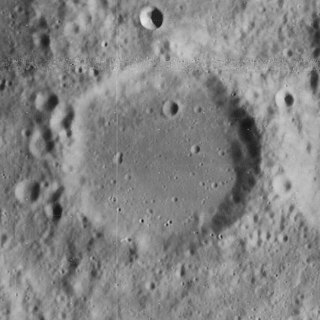
Buch is an old, worn crater that is located in the rugged southern highlands of the Moon. It was named after German geologist Leopold von Buch. It lies to the northeast of the large crater Maurolycus, and the comparably sized crater Büsching is attached to the northeast rim.

Schmidt is a small lunar impact crater that is located near the southwest edge of Mare Tranquillitatis, to the southwest of the Ritter–Sabine crater pair. It was named after German astronomer Johann Friedrich Julius Schmidt, German optician Bernhard Schmidt and Soviet astronomer Otto Schmidt. This formation is circular and bowl-shaped, with little appearance of wear due to subsequent impacts. The interior has a higher albedo than the surrounding terrain, giving it a light appearance. The exterior consists of hummocky terrain with many boulders, ranging up to 100 m or more in diameter.

Cayley is a small lunar impact crater that is located in a lava-flooded region to the west of Mare Tranquillitatis. It was named after the 19th-century English mathematician Arthur Cayley. It lies to the northwest of the smaller crater De Morgan and the larger D'Arrest. West and slightly north of Cayley is Whewell, a crater of about the same dimensions. To the north is a linear rille designated Rima Ariadaeus, which follows a course to the east-southeast.

Hahn is a lunar impact crater that is located near the northeastern limb of the Moon. The crater appears oval when viewed from the Earth due to foreshortening. It is located less than one crater diameter to the southeast of Berosus, a slightly smaller formation.

La Pérouse is a lunar impact crater that is located near the eastern limb of the Moon. It lies northwest of the larger crater Ansgarius, and to the east of Kapteyn. This crater appears foreshortened due to its location, but the rim is nearly circular when viewed from orbit.
























